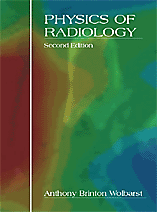
Physics of Radiology, Second Edition
Author: Anthony B. WolbarstISBN: 9781930524224 ISBN10: 1930524226
Published: 2005 | 660 pp. | Hardcover
Price: $ 110.00
Medical Physics (review of the first edition) | January 1994
The preface of this book states that it is written primarily for radiology residents, medical students in radiology courses, and interested physicians. A quick glance through it reveals its suitability for anyone wanting a well-rounded introduction to the physics of medical imaging. Written by a medical physicist, this book is entertaining as well as informational. "The book is divided into four major sections and subdivided into eleven parts consisting of 48 relatively short, concise chapters. Each chapter is augmented with informative graphs, illustrations, tables, and some clinical images. In addition, exercises (and their solutions) are sprinkled throughout each chapter to punctuate important concepts. "Section I is an excellent introduction that briefly describes each of the imaging modalities and introduces the reader to the basic processes of radiography, from the generation of a uniform x-ray beam to the analysis of the final image. "Section II lays the theoretical foundation for the rest of the book in the form of several different parts. Part I discusses energy and matter in the form of a brief review of motion, force, energy, waves, atoms, and photons. Part 2 covers the production of x rays by first introducing the reader to different electronic components and then to each part of an x-ray unit. The final chapter of Part 2 defines the characteristics of an x-ray beam with quantities such as photon fluence and air kerma, in addition to the standard quantities of exposure and dose. Part 3 covers the interaction of x-rays with matter. "Section III, titled ‘Analog X-ray Imaging,' covers the practical aspects of film-screen radiography, fluoroscopy, mammography, and tomography. Included in this section is a chapter discussing the modulation transfer function, the Wiener spectrum (briefly), and ROC CURVES. Included is a chapter on quality assurance and radiation safety. Part 6 covers dose, biologic effects, and radiation protection. "Section IV covers digital imaging modalities (including digital radiography, angiography, CT, MRI, gamma-ray imaging, and ultrasound). The physics behind each technology is discussed, and then its applications in imaging are illustrated. The final part of Section IV briefly reviews the current state of image management and communication in the radiology department. "In most instances, radiation detectors are discussed with the modalities for which they are most commonly used; for example, Geiger counters are explained in the nuclear medicine part, while ionization chambers are discussed in the chapters on detecting radiation, radiation safety, and computed tomography. In addition, brief references are made to quality assurance concerns for each of the modalities. Finally, this book proves even more practical by the addition of useful tables on the inside covers. "In summary, this is a modern, thoroughly enjoyable textbook on the physics of radiology. It will make an excellent addition to any radiology or medical physics library."
Reviewed by Tomi Van Cleve
Tomi Van Cleve, M.S. is a clinical medical physicist in the Department of Radiology at the University of Wisconsin-Madison.
